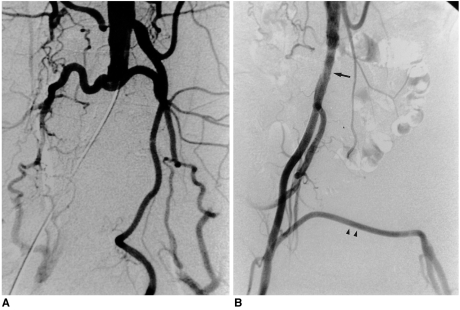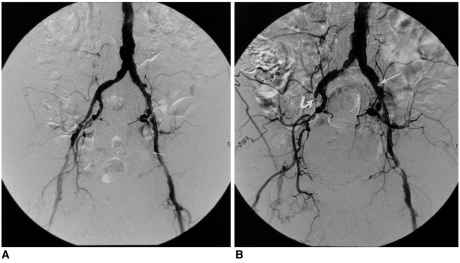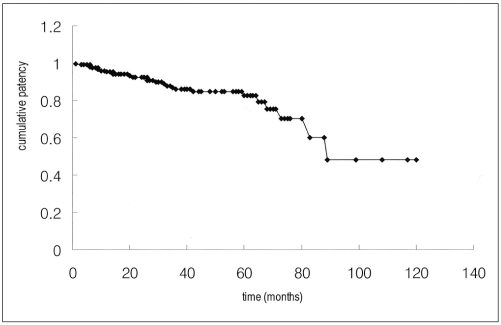Korean J Radiol.
2005 Dec;6(4):256-266. 10.3348/kjr.2005.6.4.256.
Stent Placement for Chronic Iliac Arterial Occlusive Disease: the Results of 10 Years Experience in a Single Institution
- Affiliations
-
- 1Department of Radiology and the Center for Imaging Science, Samsung Medical Center, Sungkyunkwan University School of Medicine, Korea. ysdo@smc.samsung.co.kr
- 2Division of Vascular Surgery, Samsung Medical Center, Sungkyunkwan University School of Medicine, Korea.
- 3Department of Cardiology, Samsung Medical Center, Sungkyunkwan University School of Medicine, Korea.
- 4Department of Radiology, Paik Hospital, Sangye, College of Medicine, Inje University, Korea.
- 5Department of Radiology, Paik Hospital, Ilsan, College of Medicine, Inje University, Korea.
- KMID: 1777284
- DOI: http://doi.org/10.3348/kjr.2005.6.4.256
Abstract
OBJECTIVE
We wanted to retrospectively evaluate the long-term therapeutic results of iliac arterial stent placement that was done in a single institution for 10 years. MATERIALS AND METHODS: From May 1994 to April 2004, 206 patients who underwent iliac arterial stent placement (mean age; 64+/-8.8) were followed up for evaluating the long term stent patency. Combined or subsequent bypass surgery was performed in 72 patients. The follow up period ranged from one month to 120 months (mean; 31+/-25.2 months). The factors that were analyzed for their effect on the patency of stents were age, the stent type and diameter, the lesion site, lesion shape, lesion length, the Society of Cardiovascular and Interventinal Radiology criteria, the total run off scores, the Fontaine stage and the cardiovascular risk factors (diabetes mellitus, hypertension and smoking). Follow-up included angiography and/or CT angiography, color Doppler sonography and clinical evaluation with the ankle-brachial index. RESULTS: Two hundred and eighty-four stents were placed in 249 limbs of 203 patients. The technical success rate was 98% (203/206). The primary patency rates of the stents at 3, 5, 7 and 10 year were 87%, 83%, 61% and 49%, respectively. One hundred seventy-seven patients maintained the primary stent patency until the final follow up and 26 patients showed stenosis or obstruction during the follow up. Secondary intervention was performed in thirteen patients. Lesions in the external iliac artery (EIA) or lesions in both the common iliac artery (CIA) and EIA were a poor prognostic factor for stent patency. The run off score and stent diameter also showed statistically significant influence on stent patency. The overall complication rate was 6%. CONCLUSION: Iliac arterial stent placement is a safe treatment with favorable long term patency. Lesions in the EIA or lesions in both the EIA and CIA, poor run off vessels and a stent having the same or a larger diameter than 10 mm were the poor prognostic factors for long term stent patency.
Keyword
MeSH Terms
Figure
Reference
-
1. Grollman JH Jr, Del Vicario M, Mittal AK. Percutaneous transluminal abdominal aortic angioplasty. AJR Am J Roentgenol. 1980; 134:1053–1054. PMID: 6768245.
Article2. Velasquez G, Castaneda-Zuniga W, Formanek A, Zollikofer C, Barreto A, Nicoloff D, et al. Nonsurgical aortoplasty in Leriche syndrome. Radiology. 1980; 134:359–360. PMID: 7352213.
Article3. Tegtmeyer CJ, Wellons HA, Thompson RN. Balloon dilation of the abdominal aorta. JAMA. 1980; 244:2636–2637. PMID: 7431611.
Article4. Becker GJ. Intravascular stents. General principles and status of lower-extremity arterial applications. Circulation. 1991; 83:I122–I136. PMID: 1991395.5. Hallisey MJ, Parker BC, van Breda A. Current status and extended applications of intravascular stents. Curr Opin Radiol. 1992; 4:7–12. PMID: 1627454.6. Johnston KW, Rae M, Hogg-Johnston SA, Colapinto RF, Walker PM, Baird RJ, et al. Five-year results of a prospective study of percutaneous transluminal angioplasty. Ann Surg. 1987; 206:403–413. PMID: 2959214.7. Becker GJ, Katzen BT, Dake MD. Noncoronary angioplasty. Radiology. 1989; 170:921–940. PMID: 2521745.
Article8. Gunther RW, Vorwerk D, Bohndorf K, Peters I, el-Din A, Messmer B, et al. Iliac and femoral artery stenoses and occlusions: treatment with intravascular stents. Radiology. 1989; 172:725–730. PMID: 2528159.
Article9. Rees CR, Palmaz JC, Garcia O, Roeren T, Richter GM, Gardiner G Jr, et al. Angioplasty and stenting of completely occluded iliac arteries. Radiology. 1989; 172:953–959. PMID: 2528170.
Article10. Long AL, Page PE, Raynaud AC, Beyssen BM, Fiessinger JN, Ducimetière P, et al. Percutaneous iliac artery stent: angiographic long-term follow-up. Radiology. 1991; 180:771–778. PMID: 1831274.
Article11. Vorwerk D, Gunther RW. Mechanical revascularization of occluded iliac arteries with use of self-expandable endoprostheses. Radiology. 1990; 175:411–415. PMID: 2139231.
Article12. Schurmann K, Mahnken A, Meyer J, Haage P, Chalabi K, Peters I, et al. Long-term results 10 years after iliac arterial stent placement. Radiology. 2002; 224:731–738. PMID: 12202707.
Article13. Vorwerk D, Gunther R, Schurmann K, Wendt G. Primary stent placement for chronic iliac artery occlusions: follow-up results in 103 patients. Radiology. 1995; 194:745–749. PMID: 7862973.
Article14. Nawaz S, Cleveland T, Gaines P, Beard J, Chan P. Aortoiliac stenting, determinants of clinical outcome. Eur J Vasc Endovasc Surg. 1999; 17:351–359. PMID: 10204060.
Article15. Sacks D, Marinelli C, Martin L, Spies J. Reporting standards for clinical evaluation of new peripheral arterial revascularization devices. J Vasc Interv Radiol. 2003; 14:S395–S404. PMID: 14514855.
Article16. Littooy FN, Steffan G, Steinam S, Saletta C, Greisler HP. An 11-year experience with aortofemoral bypass grafting. Cardiovasc Surg. 1993; 1:232–238. PMID: 8076036.17. Schneider JR, Besso SR, Walsh DB, Zwolak RM, Cronenwett JL. Femorofemoral versus aortobifemoral bypass: outcome and hemodynamic results. J Vasc Surg. 1994; 19:43–55. PMID: 8301737.
Article18. Huber TS, Harward TR, Flynn TC, Albright JL, Seeger JM. Operative mortality rates after elective infrarenal aortic reconstructions. J Vasc Surg. 1995; 22:287–293. PMID: 7674472.
Article19. Erdoes LS, Bernhard VM, Berman SS. Aortofemoral graft occlusion: strategy and timing of reoperation. Cardiovasc Surg. 1995; 3:277–283. PMID: 7655841.
Article20. Passman MA, Taylor LM, Moneta GL, Edward JM, Yeager RA, McConnell DB, et al. Comparison of axillofemoral and aortofemoral bypass for aortoiliac occlusive disease. J Vasc Surg. 1996; 23:263–271. PMID: 8637103.21. Gunther RW, Vorwerk D, Antonucci F, Beyssen B, Essinger A, Gaux JC, et al. Iliac artery stenosis or obstruction after unsuccessful balloon angioplasty: treatment with a self-expandable stent. AJR Am J Roentgenol. 1991; 156:389–393. PMID: 1824733.22. Hallisey MJ, Parker BC, van Breda A. Current status and extended applications of intravascular stents. Curr Opin Radiol. 1992; 4:7–12. PMID: 1627454.23. Bonn J, Gardiner GA Jr, Shapiro MJ, Sullivan KL, Levin DC. Palmaz vascular stent: initial clinical experience. Radiology. 1990; 174:741–745. PMID: 2137633.
Article24. Liermann D, Strecker EP, Peters J. The Strecker stent: indications and results in iliac and femoropopliteal arteries. Cardiovasc Intervent Radiol. 1992; 15:298–305. PMID: 1423390.
Article25. Szilagyi DE, Elliott JP Jr, Smith RF, Reddy DJ, McPharlin M. A thirty-year survey of the reconstructive surgical treatment of aortoiliac occlusive disease. J Vasc Surg. 1986; 3:421–436. PMID: 3951027.
Article26. Nevelsteen A, Wouters L, Suy R. Aortofemoral dacron reconstruction for aorto-iliac occlusive disease: a 25-year survey. Eur J Vasc Surg. 1991; 5:179–186. PMID: 1828041.
Article27. Richter GM, Roeren T, Noeldge G, Landwehr P, Allenberg JR, Kauffmann GW, et al. Initial long-term results of a randomized 5-year study: iliac stent implantation versus PTA. Vasa Suppl. 1992; 35:192–193. PMID: 1481044.28. Vorwerk D, Gunther RW, Schurmann K, Wendt G. Aortic and iliac stenoses: follow-up results of stent placement after insufficient balloon angioplasty in 118 cases. Radiology. 1996; 198:45–48. PMID: 8539403.
Article29. Cikrit DF, Gustafson PA, Dalsing MC, Harris VJ, Lalka SG, Sawchuk AP, et al. Long-term follow-up of the Palmaz stent for iliac occlusive disease. Surgery. 1995; 118:608–614. PMID: 7570312.
Article30. Palmaz JC, Laborde JC, Rivera FJ, Encarnacion CE, Lutz JD, Moss JG. Stenting of the iliac arteries with the Palmaz stent: experience from a multicenter trial. Cardiovasc Intervent Radiol. 1992; 15:291–297. PMID: 1423389.
Article31. De Vries SO, Hunink MG. Results of aortic bifurcation grafts for aortoiliac occlusive disease: a meta-analysis. J Vasc Surg. 1997; 26:558–569. PMID: 9357455.
Article32. Lee ES, Steenson CC, Trimble KE, Caldwell MP, Kuskowski MA, Santilli SM. Comparing patency rates between external iliac and common iliac artery stents. J Vasc Surg. 2000; 31:889–894. PMID: 10805878.
Article33. Johnston KW. Iliac arteries: reanalysis of results of balloon angioplasty. Radiology. 1993; 186:207–212. PMID: 8416566.
Article34. Sullivan TM, Childs MB, Bacharach JM, Gray BH, Piedmonte MR. Percutaneous trasluminal angioplasty and primary stenting of the iliac arteries in 288 patients. J Vasc Surg. 1997; 25:29–38. discussion 38-9. PMID: 9013905.35. Timaran CH, Stevens SL, Freeman MB, Goldman MH. Predictors for adverse outcome after iliac angioplasty and stenting for limb-threatening ischemia. J Vasc Surg. 2002; 36:507–513. PMID: 12218974.
Article36. Murphy TP, Webb MS, Lambiase RE, Haas RA, Dorfman GS, Carney WI Jr, et al. Percutaneous revascularization of complex iliac artery stenoses and occlusions with use of Wallstents: three-year experience. J Vasc Interv Radiol. 1996; 7:21–27. PMID: 8773970.
Article37. Dyet JF, Gaines PA, Nicholson AA, Cleveland T, Cook AM, Wilkinson AR, et al. Treatment of chronic iliac artery occlusions by means of percutaneous endovascular stent placement. J Vasc Interv Radiol. 1997; 8:349–353. PMID: 9152906.
Article38. Long AL, Sapoval MR, Beyssen BM, Auguste MC, Le Bras Y, Raynaud AC, et al. Strecker stent implantation in iliac arteries: patency and predictive factors for long-term success. Radiology. 1995; 194:739–744. PMID: 7862972.
Article39. Blum U, Gabelmann A, Redecker M, Noldge G, Dornberg W, Grosser G, et al. Percutaneous recanalization of iliac artery occlusions: results of a prospective study. Radiology. 1993; 189:536–540. PMID: 8210387.
Article40. Pentecost MJ, Criqui MH, Dorros G, Goldstone J, Johnston KW, Martin EC, et al. Guidelines for peripheral percutaneous transluminal angioplasty of the abdominal aorta and lower extremity vessels. A statement for health professionals from a special writing group of the Councils on Cardiovascular Radiology, Arteriosclerosis, Cardio-Thoracic and Vascular Surgery, Clinical Cardiology, and Epidemiology and Prevention, the American Heart Association. Circulation. 1994; 89:511–531. PMID: 8281692.
Article41. Timaran CH, Stevens SL, Freeman MB, Goldman MH. External iliac and common iliac artery angioplasty and stenting in men and women. J Vasc Surg. 2001; 34:440–446. PMID: 11533595.
Article42. Darcy MD, Vedantham S, Kaufman JA. Peripheral vascular interventions. 2001. 2nd ed. SCVIR;p. 53–70.43. Darcy MD, Vedantham S, Kaufman JA. Peripheral vascular interventions. 2001. 2nd ed. SCVIR;p. 205–220.
- Full Text Links
- Actions
-
Cited
- CITED
-
- Close
- Share
- Similar articles
-
- Subintimal Stent Placement in Patients with Long Segment Occlusion of the Iliac Artery
- Cumulative Patency Rate of Percutaneous Transluminal Angioplasty and Stent Placement for Aortoiliac Occlusive Disease
- Endovascular Management for Chronic Steno-occlusion of Iliac and Femoral Arteries
- Interventional Radiology for Vascular Diseases
- Incidence and Risk Factors of Iliac Artery Rupture during Aortoiliac Stenting




